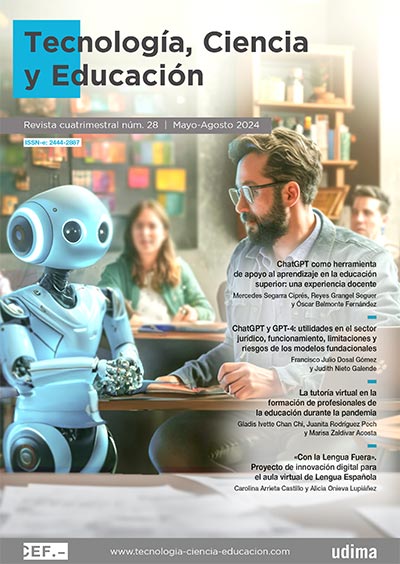«Con la Lengua Fuera». A digital innovation project for the virtual classroom of Spanish Language
DOI:
https://doi.org/10.51302/tce.2024.868Keywords:
educational innovation, gamification, educational videogames, Spanish Language, Breakout EDU, motivation, online learningAbstract
Although linguistics contents are crucial in all the degrees of the Communication field, some academic data of the Spanish Language subject –offered in the degrees of Journalism and Advertising and Public Relations of the Universidad a Distancia de Madrid, UDIMA– indicated a constant detachment from the students (men and women) towards the subject destined to work on these contents. An example of this is that more than 60 % of students did not take the final exam of the subject during the academic year 2019-2020.
With the aim of improving the commitment of the students to the subject, a digital innovation project called «Con la Lengua Fuera» was developed. The project consisted of the design of a dynamic in which digital gamification strategies were used (such as first-person narrative, multimedia language and game levels) in a Breakout EDU format. The game was designed as three activities to work both theoretical and procedural content related to Spanish Language in the Moodle learning platform. This paper describes the framework in which the innovation project was carried out and the steps that were followed for its design and implementation in the virtual classroom.
Supporting Agencies
This work has been awarded in the First Call for Grants for Innovation Projects of the Universidad a Distancia de Madrid, UDIMA.
Downloads
References
Alonso-García, S., Martínez-Domingo, J. A., Berral-Ortiz, B. y Cruz-Campos, J. C. de la. (2021). Gamificación en educación superior. Revisión de experiencias realizadas en España en los últimos años. Hachetetepé. Revista Científica de Educación y Comunicación, 23, 1-21. https://doi.org/10.25267/Hachetetepe.2021.i23.2205
Andalucía Emprende. Fundación Pública Andaluza. (2018). Genially. https://www.andaluciaemprende.es/empresas/genially/
Andreu Andrés, M.ª A., García Casas, M. y Mollar García, M. (2005). La simulación y el juego en la enseñanza-aprendizaje de lengua extranjera. Cuadernos Cervantes, 11(55), 34-38. http://hdl.handle.net/10251/16011
Arrieta-Castillo, C. y Celorrio Aguilera, I. (2021). El juego comunicativo. Planificar y gestionar el aula con dinámicas de juego. En C. Arrieta-Castillo. (Ed.), Discurso, comunicación y gestión del aula de ELE (pp. 223-264). enClave-ELE.
Bourgonjon, J., Valckle, M., Soetaert, R. y Schellens, T. (2010). Students' perceptions about the use of video games in the classroom. Computers & Education, 54(4), 1.145-1.156. https://doi.org/10.1016/j.compedu.2009.10.022
Cabero Almenara, J. (2010). Los retos de la integración de las TIC en los procesos educativos: Límites y posibilidades. Revista Perspectiva Educacional, 49(1), 32-61. https://goo.gl/Jz49mQ
Chaves Yuste, B. (2019). Revisión de experiencias de gamificación en la enseñanza de lenguas extranjeras. ReiDoCrea, 8, 422-430. http://hdl.handle.net/10481/58021
Consejo de Europa. (2002). Marco Común Europeo de Referencia para las Lenguas: aprendizaje, enseñanza, evaluación [Trad. Instituto Cervantes]. Ministerio de Educación, Cultura y Deporte/Grupo Anaya. https://cvc.cervantes.es/ensenanza/biblioteca_ele/marco/cvc_mer.pdf
Cortés Moreno, M. (2000). Guía para el profesor de idiomas: didáctica del español y segundas lenguas. Octaedro.
Gallego Aguilar, A. F. y Ágredo Ramos, A. F. (2016). Implementando una metodología de gamificación para motivar la lectura y escritura en jóvenes universitarios. Revista Kepes, 13(14), 61-81. https://doi.org/10.17151/kepes.2016.13.14.4
Gee, J. P. (2003). What Video Games Have to Teach us About Learning and Literacy. McMillan.
Gros Salvat, B. (2014). Análisis de las prestaciones de los juegos digitales para la docencia universitaria. Revista Interuniversitaria de Formación del Profesorado, 79(28.1), 115-128. https://www.redalyc.org/pdf/274/27431190008.pdf
Instituto Cervantes. (2022). Competencia comunicativa. Diccionario de términos clave de ELE. Centro Virtual Cervantes. https://cvc.cervantes.es/ensenanza/biblioteca_ele/diccio_ele/diccionario/competenciacomunicativa.htm
Marín Díaz, V. (2013). Los videojuegos y los juegos digitales como materiales educativos. Síntesis.
Núñez Sabarís, X., Cea Álvarez, A. y Silva Dias, A. (2019). Literatura por tareas y gamificación: novela policíaca y geografías culturales. Tejuelo, 30, 261-288. https://doi.org/10.17398/1988-8430.30.261
Peñalva, S., Aguaded, I. y Torres-Toukoumidis, Á. (2019). La gamificación en la universidad española. Una perspectiva educomunicativa. Revista Mediterránea de Comunicación, 10(1), 245-256. https://doi.org/10.14198/MEDCOM2019.10.1.6
Pindado, J. (2005). Las posibilidades educativas de los videojuegos. Una revisión de los estudios más significativos. Píxel-Bit. Revista de Medios y Educación, 26, 55-67. http://www.redalyc.org/articulo.oa?id=36802605
Pivec, M., Dziabenko, O. y Schinnerl, I. (2003). Aspects of game-based learning. En H.Maurer y K. Tochtermann, (Eds.), Proceedings of the 3rd International Conference on Knowledge Management (pp. 216-225). Springer Verlag Heidelberg. https://www.academia.edu/2376082/Aspects_of_game_based_learning
Prensky, M. (2001). Digital natives, digital immigrants. On the Horizon, 9(5), 1-6. https://www.marcprensky.com/writing/Prensky%20-%20Digital%20Natives,%20Digital%20Immigrants%20-%20Part1.pdf
Real Academia Española. (2010). Ortografía de la lengua española. Espasa.
Rice, L. (2009). Playful learning. Journal for Education in the Built Environment, 4(2), 94-108. https://www.tandfonline.com/doi/full/10.11120/jebe.2009.04020094
Rodríguez Melchor, M.ª D. (2015). La gamificación de la enseñanza de competencias comunicativas: una experiencia en el aula de Retórica Persuasiva y Oratoria. Repositorio de la Universidad Pontificia de Comillas. https://repositorio.comillas.edu/xmlui/handle/11531/28365
Sánchez-Mena, A., Martí-Parreño, J. y Aldás-Manzano, J. (2017). The effect of age on teachers' intention to use educational video games: ATAM approach. Electronic Journal of e-Learning, 15(4), 355-366. https://files.eric.ed.gov/fulltext/EJ1154704.pdf
Shaffer, D. W., Squire, K. R., Halverson, R. y Gee, J. P. (2005). Video games and the future of learning. PDK. Phi Delta Kappan, 87(2), 105-111. https://doi.org/10.1177/003172170508700205
Villalustre Martínez, L. y Moral Pérez, M.ª E. del. (2015). Gamificación: estrategia para optimizar el proceso de aprendizaje y la adquisición de competencias en contextos universitarios. Digital Education Review, 27, 13-31. https://doi.org/10.1344/der.2015.27.13-31
Wastiau, P., Kearney, C. y Berghe, W. van den. (2009). How Are Digital Games Used in Schools? European Schoolnet. http://games.eun.org/upload/gis-full_report_en.pdf
Werbach, K. y Hunter, D. (2012). For the Win: How Game Thinking Can Revolutionize Your Business. Wharton Digital Press.
Wijman, T. (08/05/2020). The World's 2.7 Billion Gamers Will Spend $159.3 Billion on Games in 2020; The Market Will Surpass $220 Billion by 2023. Newzoo. https://newzoo.com/insights/articles/newzoo-games-market-numbers-revenues-and-audience-2020-2023/


























